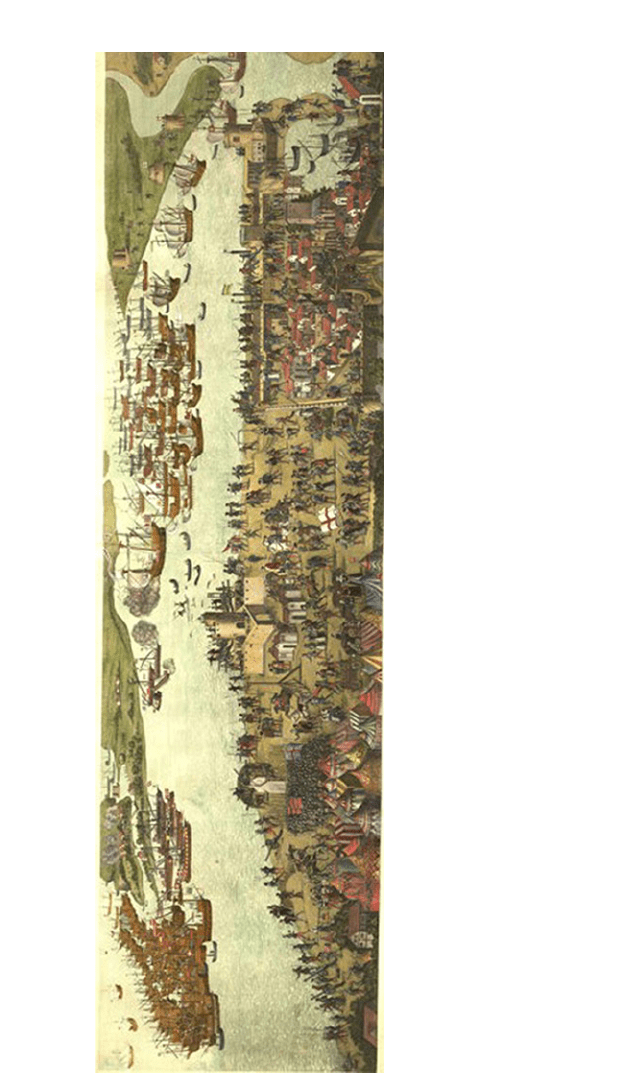Potter David. Henry VIII and Francis I
Подождите немного. Документ загружается.


370 chapter eight
It is easy to forget that the English eet in this period needed oared
vessels, primarily galleys, of course.
100
e Great Galley, though, was
rebuilt as a sailing ship by 1540 and re-named the Great Bark. e
Galley Blanchard was captured from the baron de Saint-Blancard in
1546 but the Galley Subtle, sometimes called the Roo (or Row) Galley,
was for a long time the only true galley among the King’s ships.
Marillac reported the plan for six ‘gallères subtilles’ in November 1540,
designed the more easily to maintain communications with Calais and
patrol the coasts at times when the winds were unreliable. A year later
there were payments to William Gonson for building a ship already
called the Gallye Suttel. It may have been completed by the summer
of 1543.
101
Galleasses looked very much like great ships though were
somewhat lighter and could be rowed by a bank of oars on the lower
deck at need. ere were also the new oared vessels, the ‘rowbarges,’
much smaller and lighter vessels which were very handy in combat
when the weather was unreliable. A key gure here was a Frenchman,
Pierre de Bidoux, sr de L’Artigue, nephew of Prégent de Bidoux, who
had commanded the French Mediterranean galleys against Henry in
1513. L’Artigue was himself vice-admiral of Brittany and had led gal-
ley eets in the wars of the 1520s. He had been captured on his ship
La Ferronière (thereaer a prize and renamed the Lartique), described
by Lord Admiral Lisle as ‘a tall barke and well appoyntyd,’ on the way
from Scotland shortly aer the start of the Franco-Imperial war in
1542, accused of piracy. e French government protested but he con-
tinued to be held.
102
In a statement in 1543, he claimed to have made
seven voyages to the west coast of Scotland, the last in 1524 when a
French army accompanied Albany to Scotland, and outlined the com-
100
E.R. Adair, ‘English galleys in the sixteenth century’ EHR, 35, no. 140 (1920),
pp. 497–512 argues that, in the light of ambiguous terminology, the formula that where
a ships had a greater complement of soldiers and sailors than its tonnage, then it was a
galley. See also J. Bennell, ‘e Oared vessels’ in Knighton and Loades, Anthony Roll,
pp. 34–38; D. Childs, ‘Shock and Oar: Mary Rose and the Fear of French Galleys’
History Today, April 2007.
101
Marillac to Francis I, 16 Nov. 1540, Kaulek, p. 243; L&P, XVII, 258 (fo. 54);
XVIII, ii, 231 (28 Nov. 1541); Lisle to Henry VIII, 11 July 1543, L&P, XVIII, i, 867.
102
Remonstrance of Nicolas Roussel, Nov.–Dec. 1542, Caius College Cambridge,
MS 597/362, p. 201 (L&P, XVII, 1159.2): ‘remonstre que revenant de voyage d’Escosse
il fut prins le long de la coste d’Engleterre par les Angloys avec tous ses compaignons et
la nef appellez La Ferronniere. Puis peu de jours en ca, ilz ont esté delivrez de prison.’;
Paget to Henry VIII, 2 Dec. 1542, St.P., V, no. DCCXCIII; e Council discussed the
case of Lartigue and other French sea captives on 6 April 1543 APC, I, p. 106. (L&P,
XVIII, i, 372), Lisle to Paget, 7 Nov. 1543, NA SP1/182, fo. 73 (L&P, XVIII, ii, 348).

the admirals
’
war 371
modities of the ports around Dumbarton. He also suggested that the
English might have as many pilots from Brittany as they wanted.
103
At
the start of the Anglo-French war (8 July 1543), perhaps anxious to be
free, he accepted a pension of £50, increased to £75 in 1545 and seems
to have oered a rather foolhardy plan for a descent on Brittany for the
capture of Le Conquet and other places at the far west of Brittany such
as Brest as well as of western ports such as La Rochelle.
104
L’Artigue’s
expertise was in the construction and command of galleys and he had
oered his services to Henry for this purpose; the French ambassador
just before his departure got hold of a plan oered by L’Artigue for
doing harm to Francis I. ough there is some evidence that he was
a double agent, he certainly submitted a plan for the building of four
galleys in 100 days with advice on the treatment of timber and on their
manning by Venetian sailors.
105
Only the Galley Subtle was built in
these years (1543/4) but the King commanded the building of 9 more
galleasses and 13 rowbarges in which L’Artigue may have played a
part.
106
ese were highly active in the conicts of 1545–1546.
Information from French naval experts proved valuable in other
ways. Marillac remarked in October 1540 that many of the pilots
and mariners in English service were foreigners.
107
Many of these
were Normans or Bretons, perhaps exiles banished for crimes such
as piracy, including Jean Ribauld and Jean Rotz of Dieppe.
108
Rotz,
103
Oer by L’Artigue, 1543, L&P, XVIII, ii, 541.
104
Copy of L’Artigue’s plan intercepted by the Imperials BL Add. 28593, fos. 185–188
(L&P, XVIII, i, 662, ii); ibid., ii, 107(11).
105
D’Orthe to Francis I, 7 June 1543, Imperial intercept, L&P, XVIII, i, 662; Saint-
Aulbie to L’Artigue, 29 June 1543, NA SP1/182, fo. 196 (L&P, XVIII, ii, app. 16):
L’Artigue had passed on his advice to Cardinal de Tournon in France, namely ‘l’advis
que vous avez baillé pardelà du chemin que une armee de mer doit tenir.’ Tournon
had replied that ‘vous luy faictes merveilleusement grant service’ and those places
would be secured. He would be awarded 1200 cr.; ‘Qui seguitanno gli nomi de li for-
tamenti et apparelliamento d’una galea fatto et nominato per Lortigua del Paeze de
Franza,’ NA SP1/182, fos. 192–196 (L&P, XVIII, ii, app. 15). A French pilot who had
entered English service, was taken in the ght o Bareur in July 1543 and aerwards
beheaded. (La prise et deaicte, ed. Montaiglon, Recueil, p. 200). L’Artigue, who asso-
ciated with Berteville and other French traitors, died in poverty at York in October
1547 (Lefebvre-Pontalis, Correspondance politique d’Odet de Selve, 62, 234).
106
Bennell, ‘Oared Vessels,’ p. 34.
107
Marillac to Francis I, 1 October 1540, Kaulek, p. 227.
108
E.-T. Hamy, ‘Jean Roze, hydrographe dieppois du milieu du XVI
e
siècle’ Bulletin de
Géographie Historique et Descriptive, 2 (1889), 90–91. E.G. Taylor, Tudor geography
1485–1583 (London. 1930), p. 63; idem., ‘French cosmographers and navigators
in England and Scotland, 1542–1547,’ Scottish Geographical Magazine, 46 (1930);
P. Barber, ‘England I: Pageantry, Defense and Government: Maps at Court to 1550’ in

372 chapter eight
of Scottish descent from a family long settled in France, presented
Henry VIII with a meridional compass and a Treatise on navigation in
1542, followed by an elaborate Boke of Idrography copiously equipped
with detailed naval charts prepared in the late 1530s.
109
Rotz, who was
given denizenship and an annuity, was required to provide maps and
expertise for English eets operating in the North Sea against Scotland
as well as in the narrow seas, though, with the preparation of a new
campaign against the Scots aer Henry VIII’s death, he and Ribauld
were anxious to return to French service by early 1547.
110
What was life aboard a great English warship like? We now have, of
course, the priceless evidence of the near-completely excavated Mary
Rose to penetrate this world, with all its rich evidence on the daily lives
and needs of a community of soldiers and sailors at sea.
111
In addition,
the Anthony Roll of 1546 gives a comprehensive survey of the King’s
ships. From the latter,
112
we learn that the ship, rebuilt to 700 tons and
thus the second largest ship of the eet, normally had a complement of
185 soldiers, 200 sailors and 30 gunners. She was to carry 91 guns on
three decks with the 14 heaviest on the main deck. ese included 15
carriage-mounted bronze guns (including two of the only four bronze
cannon in the eet). e rest were a mixture of iron guns and smaller
anti-personnel weapons. ere were 52 handguns, 250 longbows (with
chests found in excavation that would account for between 8500 and
D. Buisseret (ed.) Monarchs, Ministers and Maps (Chicago/London, 1992), pp. 36–41.
Less is known about Ribauld. e Council authorised his pay of £35 for an annuity
on 7 April 1546, when he was detailed to serve with Lisle’s ships in the Narrow Seas
(APC, I, p. 371 (L&P, XXI, i, 561); records of the payment survive for 1545 (L&P,
XX, ii, 707).
109
Jean Roze, Boke of Idrography, ed. H. Wallis (Oxford, 1981) contains a survey of
practically all that is known about Rotz.
110
Ribauld seems to have been assigned for service in October 1546 but whether
at Boulogne or in Scottish waters is unclear (APC, I, p. 370); Lefebvre-Pontalis, Cor-
respondance politique de Odet de Selve, no. 43; ibid., pp. 85, 118–119. e subject is
fully explored in E. Bonner, ‘e recovery of St Andrews Castle in 1547: French naval
policy and diplomacy in the British Isles,’ EHR, 111, no. 442 (1996), 578–598. She
argues, p. 583, that both Roze and Ribauld passed on their accumulated knowledge of
English plans to Henri II and Montmorency.
111
M. Rule, e Mary Rose (1982); D. Childs, e Warship Mary Rose: the Life and
Times of King Henry VIII’s Flagship (Chatham, 2007); A. McKee, ‘e complement of
the Mary Rose’ MM, 72 (1986); J. Watt, ‘e surgeons of the Mary Rose: the practice
of surgery in Tudor England’ MM 69 (1983); D. Loades and C.S. Knighton, Letters
from the Mary Rose (Sutton: 2003).
112
Knighton and Loades, Anthony Roll, pp. 15–19.

the admirals
’
war 373
9000 arrows), 300 sta weapons and 480 darts. Artillery found in the
excavation revealed that most of the guns had been cast between 1536
and 1543.
In 1543–1544, the English divided their eet between keeping the
Narrow Seas secure and protecting operations in Scotland. In addition,
Henry himself was keen to use his ships to cripple the Franco-Flemish
herring sheries and ordered the Pansy and the Lesse Gally and eight
other ships into action in November, even though they were not pre-
pared and the eect on relations with Flanders was dicult.
113
In April
1544, for instance, there were just 8 royal ships in the Narrow Seas,
including the Lesse Gallyas, the Primrose, the New Bark, Dragon, Mary
James, Great Pinnace, Small Pinnace, Caundish ship, with crews of 870
and costing £283.19.4 p.m. Plainly this was just a covering squadron.
Real English sea-power was put forth against Scotland at the time in
support of the landing at Leith commanded by Hertford in May 1544,
with a squadron of royal ships to escort the nearly 200 merchant ships
(see chapters 2 and 5).
As for the numbers of ships the English could command in 1545,
an intelligence report sent to Charles V in February suggested that
aer recent captures of French vessels, the English could now send out
80–100 armed ships.
114
At the end of May, an estimate was made for
the money needed for 3600 men under Carew’s command over and
above 2400 who were already with the eet. e pay at 6/8d a month
was £1,200 and the total cost with conduct and victuals £3,500.
115
At the
start of June, Lisle had assembled 160 ships with 12,000 men aboard.
116
Nonetheless, assembling the full complement of the eet was a major
problem in view of the terrible weather in the Channel. Just before 24
June, Lisle’s squadron had moved westwards beyond Wight but had
then been driven back by south-westerlies to the narrow Seas. Here he
pondered his options. Should tack back westwards?:
whiche I thought not convenyent, conjecturing that with those streynable
wyndes, the rest of tharmye comyng out of ames, and also the Henry,
with the Mary Roose, sholde be in the Downes: whiche place, althought
it was more paynfull, thenne to have come in with the Wight, we made
113
Lisle to Paget, 7 Nov. 1543, NA SP1/182, fo. 73 (L&P, XVIII, ii, 348).
114
L&P, XX, i, 615.
115
Estimate 28 May 1545, SP 1/201 f. 126 (L&P, XX, i, 823).
116
Hall, Triumphante Reigne, ed. Whibley, II, p. 351; L&P, XX, i, 823.

374 chapter eight
towardes, were we arryved in savetye, yesterdaie, at aer none; fynd-
ing there the Harry, and the Mary Roos, and none of the shippes that
cometh out of the ames, neither smale nor great, saving only the
smale shalopp, that conveyed my Lorde Great Master to Quynbroughe,
which came unto me uppon Saturdaie last, in the morning, and hath
been with me ever sythens. e resydew remayned at Gravesende, upon
payment, which I woolde hadde been dierred, untill there arryvall in
the Downes; for they hadde no wyndes sythens to bringe them aboute
the Forlande.
117
e problems of assembling all the ships in one place are evident.
e summer of 1545, with the French naval attack looming, required
a feverish response in English coastal defence. Commissions of array
were issued on 7 May and 14 June. Leading councillors, Norfolk,
Suolk and Russell, took charge of sections of the coast. Along the East
Anglian coast the Duke of Norfolk inspected the beacons and reported
the people in good heart and anxious to cut any French army o from
its ships should they land. Only Yarmouth seemed to him vulnera-
ble to a major landing and here good progress had been made on a
bulwark. e country was stripped of troops in the summer of 1545
and Norfolk was required to raise 5000 men for Boulogne from his
‘commission.’
118
Locally, reliable courtier gentry were commissioned
to act as liaison. John Gage, for instance, was on the Sussex coast
reporting the movements of the French eet in the narrow seas.
119
He
acted as liaison between his kinsman, Lisle, the eet and the Council,
informing Lisle of admiral d’Annebault’s movements out of the nar-
row seas and transmitting Lisle’s news.
120
He also seems to have been
arranging for the supply ships to rendezvous with Lisle’s eet.
121
Local
agents proposed that the guidance beacons at Spanish Nok, Land’s
End and in the ames estuary at Whitstable and Reculver be taken
down so that no great ships could enter those waters without danger.
122
117
Lisle to Council, undated but c. 24 June 1545, St.P., I, ii, no. CCXIV.
118
Norfolk to Paget, Orfordness, 27 June 1545, L&P, XX, i, 1045; Council to Nor-
folk, 26 July 1545, BL Harl. 6989, fo. 137.
119
D. Potter, ‘Sir John Gage, Tudor Courtier and Soldier,’ English Historical Review.
474 (2002), 113–114. Suolk and others to Paget, Portsmouth, 2 and 3 Aug. 1545,
L&P, XX, ii, 14, 24.
120
Lisle to Henry VIII, 12, 18, 21 Aug. 1545, L&P, XX, ii, 108, 158, 183. Letters of
Privy Council to Gage and Sussex justices, 11 Aug. 1545, APC, I, p. 226 (L&P, XX,
ii, 94).
121
Lisle to Gage, 17 Aug. 1545, St. P., I, p. 816 (L&P, XX, ii, 151).
122
L&P, XX, i, 1174, 2.

the admirals
’
war 375
Early in the summer Paget drew up a paper for the King which listed
the strengths and weaknesses of coastal defence.
123
The Campaign in the English Channel, 1545
e French eet nally made its way out of Le Havre on 17 July.
Annebault, as a result of the disaster of the great carrack, had been
forced to delay his departure but only for a few days. Having trans-
ferred to the new Grande Maîtresse, he put out in command of the
main battle (the terminology of land armies of course retained), with
Taix in command of the van and Boutières of the rear-guard. Salvoes
of artillery were answered from the clis where the King was stationed.
e Papal nuncio, writing from Hareur, put the eet at 300 sail, car-
rying, besides the sailors, 15,000, ‘tutti bone genti’ either Gascons or
Spaniards, 4000 pioniers (‘guastatori’). Nobles had ocked to serve
and as a result caused problems of precedence with Leone Strozzi, but
the King forbad too many from going because of the likely dangers.
124
What were the eet’s strategic and tactical objectives? Invasion of
England was the primary aim, possibly to establish a foothold on or near
the Isle of Wight as a bargaining counter for Boulogne. One observer
had heard in May that the plan was to rendezvous o Cornwall with
a Scottish eet, land in two or three places to take and hold some for-
tresses, and then move on to the Narrow Seas to secure the building
of the new fort at Boulogne.
125
However, there were major strategic
limitations.
126
e supply of an expeditionary force, however substan-
tial, was bound to be problematic unless lines of communication were
assured and only the elimination of the English eet could guarantee
123
St.P., I, ii, no. CCXI: a paper endorsed 1545 corrected by Paget: For the sea
coasts: e Lord Chamberlain and Master of the Horse shared one region including
the Isle of Wight, arrangements for their support and munitions for Portsmouth. Sey-
mour at Dover with gentlemen of Kent to have special commission. Auchar in anet
with artillery and 300 men. Artillery for the clis of Kent. Darcy in Essex and bulwarks
planned at Lowesto Roads and Yarmouth.
124
Guidiccione to Farnese, 18 July 1545, ANG III, p. 375.
125
Desjardins, III, p. 163: ‘pigliare une due o tre luoghi, e forticarli, lasciandovi
dentro guardie competenti.’
126
Loades, Northumberland p. 69 argued that ‘such a scheme makes little tactical
sense’ and that the main objective was Boulogne but it seems to me unlikely that such
an unprecedentedly great eet would have been assembled simply to support the army
at Boulogne. at could have been done with half the ships. e opportunistic seeking
of a major battle in the Channel seems more likely.

376 chapter eight
that. To capture a town such as Southampton or Portsmouth might
seem attractive but holding on to it against counter-attack when sup-
plies of labour and building material for fortications were limited
made such a plan hazardous. e Isle of Wight had some advantages
as an objective in that, cut o from the mainland as it was, a place
could be fortied on it with reasonable security. Even this, though,
could scarcely be held on to without absolute control of the Channel.
For these reasons, it is not surprising that the French campaign devel-
oped eectively into a massive raid without long-term consequences.
A permanent base on Wight would have meant diverting the eet from
pressure on Boulogne. Martin du Bellay, aer all fairly high in the
French command structure, summed up the objectives as the dislodge-
ment of the English from Boulogne by pressure on land and sea. e
French eet would be great enough to be able to meet the English eet
and interrupt communications between England and Boulogne while
the land army advanced ‘and as the opportunity presented itself, land
in England.’
127
Put like that, the invasion of English territory seems
more like the icing on the cake than a primary objective.
Misfortune seemed to pursue the French Admiral. e eet crossed
the Channel fairly quickly; du Bellay says it was o the Isle of Wight by
18th. Reconnaissance up to Saint Helen’s Point (Nettlestone’s Point)
revealed an English eet of 60 good ships at Spithead and in the Solent,
which came out of harbour to ght, favoured by the wind, though
then retreated under cover of the fortresses around Portsmouth, which
had been strengthened in the summer of 1544.
128
eir anchorage in
Portsmouth Harbour was an inestimable advantage. In addition, the
keel of Annebault’s galley had been damaged on a reef as it came out
of Honeur harbour and the vessel began to ship water. It had to put
back to Dieppe and then Le Havre for repairs. Annebault transferred
to the Venetian ship, the Contarina, his third agship.
129
e follow-
ing day, 19th, Annebault disposed his centre on the Contarina with 30
127
Du Bellay, Mémoires, IV, pp. 282–283: ‘et où l’occasion se presenteroit prendre
pied en Angleterre.’
128
See reports of Knyvet 10, 17 June 1544, L&P, XIX, i, 659, 718; action was advised
to prevent a French landing on Portsea Island at the same time ‘it is but oon nightes
sailing from the New Havon, Dieppe, Treport, Harete, Hondete and the river of
Seyne thider. And what fayr and easy landing thennemyes maye have two myles
togeders within the said isle if they attempte an entreprice.’ (List of ordnance at Ports-
mouth, June 1544, NA SP1/188, fo. 166(188)v (L&P, XIX, i, 719).
129
Du Bellay, Mémoires, IV, pp. 286–287; La Roncière, Marine, III, pp. 420–424.

the admirals
’
war 377
other ships; to his right was Boutières’ squadron with 36 and Curton
on the le with a similar number. e battle plan was for the galleys
to go out rst to challenge the English in their anchorage, ring their
artillery to provoke them to attack. ey would then fall back on the
main eet if the wind changed.
130
e English had the worst of the
weather in the morning and the galleys were therefore at an advantage
but there were no notable losses except for the humiliating sinking
of the Mary Rose in full view of Henry VIII, who had come down to
Portsmouth to view the battle from Southsea castle. Du Bellay claimed
that it was sunk ‘à coups de canon.’ e Mary Rose was an old ship
but had been extensively rebuilt in 1536. It was generally reported in
England that, overloaded and with her lower gun ports open near the
water-line, she was the victim of a freak accident when a gust of wind
caused her to keel over. Recent research, though, has raised the pos-
sibility that the great ship was indeed sunk by a French cannon shot.
131
Lisle, on the Great Harry was also under pressure until the weather
turned in favour of the English. e English rowbarges (light galleys)
showed their superiority in manoeuvre at this point and the French
galleys came under attack. Leone and Piero Strozzi, in command of
the galleys, turned to stand against them and Annebault was about to
signal the whole eet to join in the counter-attack, when, according
to du Bellay, the English retired. Annebault, fearing a trap, called o
the attack.
132
Annebault seems at this point to have been trying to provoke the
English to abandon their defensive posture. Du Bellay tells us that he
‘decided to try other means to draw them out.’ He knew Henry was
present watching the battle from the shore and decided to land on the
130
Du Bellay, Mémoires, IV, pp. 288–289. Martin du Bellay seems to have had
access to the order of battle for the day.
131
M. Rule, e Mary Rose, pp. 36–38; D. Childs, e Warship Mary Rose, pas-
sim; Dominic Fontana http://userweb.port.ac.uk/~fontanad/maryrose; Van der Del
to Charles V, 24 July 1545, L&P, XX, i, 1263 makes clear contemporary belief about
the gun ports. For discussion, Loades, Northumberland, p. 70.
132
Du Bellay is clear about the advantage of the rowbarges: ‘Il y a une espece de
navires particulieres, dont usoient noz ennemis, en forme plus longue que ronde et
plus estroitte beaucoup que les galleres, pour mieulx se regir et commander au cou-
rantes qui sont ordinaire en ceste mer; à quoy les hommes sont si duits qu’avecques
ces vaisseaux ils contendent de vitesse avecques les galleres, et les nomment ram-
berges.’ e rowbarges also had artillery mounted ‘en pouppe.’ He also stressed how
long it took for the French galleys to turn themselves around. French losses were
‘quelques forçats et de quelques soldats privez.’ (Mémoires, IV, p. 290).

378 chapter eight
Illustration 7 e Encampment of the English Forces near Portsmouth together with a View of the English and French eets
at the commencement of the action between them on the XXXth July MCXLV (e sinking of the Mary Rose). Engraved from
a Coeval Painting, at Cowdray in Sussex, the Seat of Lord Viscount Montague. Drawn from the Original, by S.H. Grimm.
Engraved by James Basire, 1788. Sumptibus Societatis Antiquariorum Londini. Publish’d according to Act of Parliament,
23rd April, 1788.

the admirals
’
war 379
Isle of Wight and burn the country so as to provoke his indignation
‘such that he would make his ships sally forth in support.’ From 21
July, the French landed on the island and burned the villages until they
met opposition from local cavalry. Daily the troops were evacuated
and daily they landed again.
133
Such tactics could not go on for long and
Annebault had to decide what to do next; stay on the Isle of Wight and
establish a base or move to support the French army at Boulogne. Du
Bellay tells us that on 23 July Annebault assembled all the captains and
pilots on his galley to hold a council of war. e Admiral put the case
for attacking the English head on and called in evidence his superior-
ity in numbers of men and ships. e pilots, though, raised doubts
about the possibility of approaching the shore without ‘evidente perte.’
e approach into Portsmouth Harbour would only allow four ships
to advance in line, so the channel could easily be defended. e eet
would be at the mercy of the current and the winds. e fortications
would bring artillery to bear on them. When it was suggested that the
eet could ght at anchor to oset the currents, the pilots pointed
out that cables could break or drag. Annebault at rst thought all this
cowardice, while the Strozzis called loudly for attack. But when the
Admiral asked them to put their opinion down on paper, they refused
and when he asked them to sign up to the opposite point of view, they
also refused, much to his exasperation. e incident revealed what was
to become an increasing problem on the French side: the breakdown of
trust between the French Admiral and his Italian galley commanders.
134
133
Du Bellay, Mémoires, IV, pp. 292–294: ‘resolut de tenter par autres moyens de
les attirer’ .. ‘tant qu’il feroit partir ses navires pour aller au secours.’
134
Alvarotti, the Ferrarese ambassador, was informed of this exchange by omaso
del Vecchio: ‘che mentre l’armata di Francia era all’isola di Voich et la Inglese dentro
di quell porto, che Mons. Almiraglio voleva andare a combatterla, perche dubitava
di nostra vere acqua a bastanza, convoco tutti i piloti et demando il parer loro, se
credevano che haveria acqua assai da potere intrare et andare per combattere. Dis-
sero tutti che non haveria piu di uno braccio d’acqua, molti dicono che questa fu una
nta per mostrare voluntà di combattere; sia come si voglia il signor prior di Capua
et Pietro Strozzi dissero che vi saria piu di 4 braccia d’acqua et che si poteva combat-
tere. All’hora, Monsr Almiraglio fece loro presentare inanzi uno folio di carta, dicendo
che si sottoscrivessero, perche su la parola lora voleva andare a combattere. Risposero
che non lo volevano fare, perche non erano piloti. S. Ex. disse sottoscrivete dunque
il contrario. Risposero anco non volerlo fare per la medesima ragiione, di modo che
S. Ex. Reste molto malsodisfatta da loro, et per quanto mi ha ditto il signor Ludovico
Biraga, scrisse a Sua Maestà il tutto condamnandoli per huomini rotti et periculosi,
et non da governo.’ (to Duke Ercole II, Dieppe, 14 Aug. 1545, ASM, Francia, B 21,
fasc. 1, fo. 210 (decipher).
